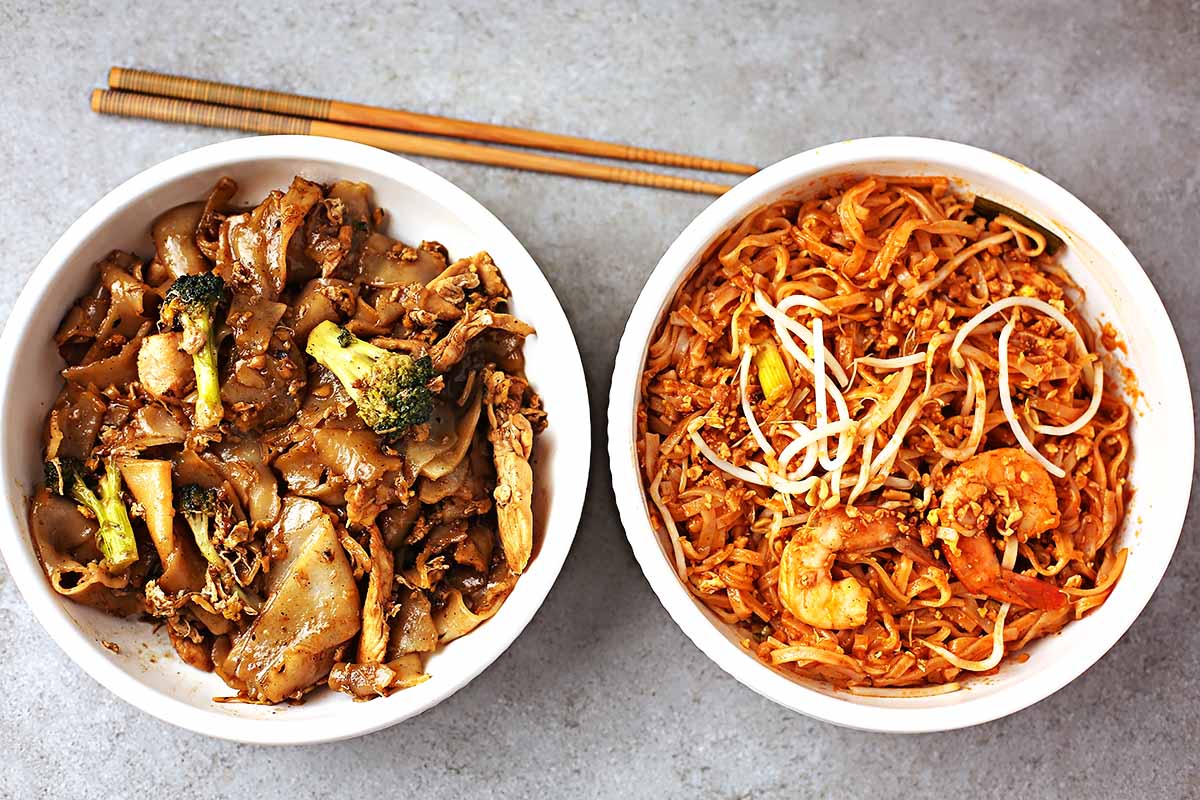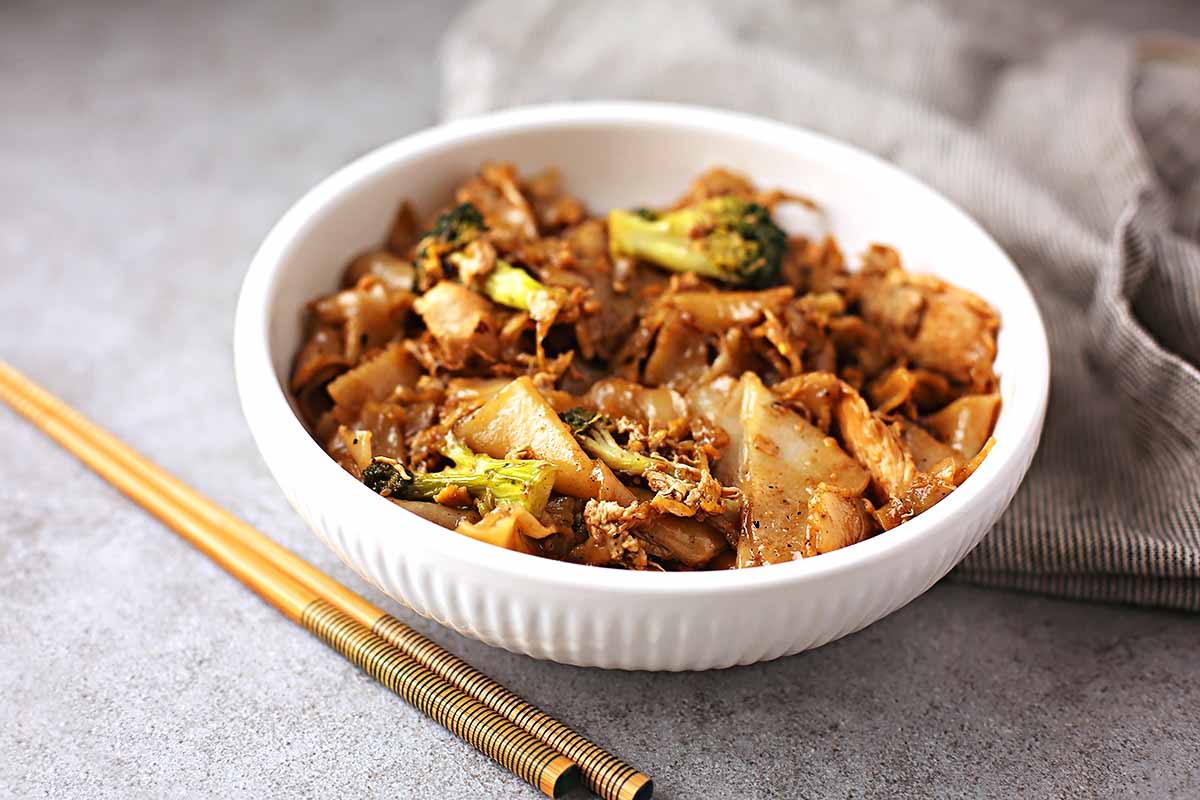At first glance, pad see ew vs. pad thai may seem identical. They are two of the most popular Thai dishes, both made with rice noodles.
There are some important differences and similarities between them. Knowing these details will come in handy when you find yourself in a Thai restaurant.

Pad see ew is a stir-fried rice noodle dish. It is made with rice noodles, pork, chicken, shrimp, and vegetables.
Pad See Ew is a Thai food, and the word means “fried with soy sauce.”
This stir-fried noodle consists of flat rice noodles, dark and charred sauce, meat, and vegetables. When cooking pad see ew, chefs use a wok.
A wok is a deep round-bottomed pan with a long handle commonly seen in Chinese cuisine.
Woks handle high heat well, and their non-stick surface means you don’t need to use as much oil. The length of the handle will also protect you from the heat.
There’s a lot of space inside the wok compared to a frying pan, so you’re free to stir and toss ingredients around. This makes it the perfect choice for a cooking pad see ew.
This Thai-style fried noodles trace their origins back to China.
When locals from the Guangdong province settled in Bangkok, they brought their woks and stir-frying techniques with them.
The Thais quickly adopted both into their cooking style and considered them essential to many of their recipes.
Due to close borders between Southeast Asian countries, it’s not surprising to learn that pad see ew has many variations.
The traditional version uses beef, but you can replace it with pork, chicken, or assorted seafood.
It’s also similar to other dishes like the chow fun from Cantonese or the char kway teow from Malaysians.

Thanks to its soy sauce base, pad see ew has a salty and savory flavor.
The sweet oyster sauce gives it the right amount of sweetness, and the thick and chewy noodles absorb most of the flavoring. The beef also lends an umami taste to the dish.
The best way to eat pad see ew is to get a portion of each ingredient into your fork.
By doing this, you’ll be able to taste its full potential.
It’s a combination of caramelized noodles with a bit of that charred and smoky flavor, and the Chinese broccoli gives a crunchy texture.
The tender beef on top of the savory bowl is the perfect viand for an all-carb dish.
The good news is that you don’t need to travel to Thailand to know what pad see ew tastes like. You can try cooking the recipe at home.
The secret to an authentic pad see ew flavor is caramelizing the noodles.
Here is one of the best recipes for pad see ew.
Ingredients:
Directions:
Pad Thai is a stir-fried rice noodle dish. It is made with rice noodles, chicken, shrimp, tofu, and vegetables.
Phad Thai is Thailand’s national dish. The term translates to “Thai stir-fry.”
The recipe includes a tamarind-based sauce, fried rice noodles, shrimp, vegetables, and peanuts, among other ingredients. It also requires a wok to achieve its authentic flavor.
When eating pad thai, it’s recommended to pair it with chili peppers or lime juice.
It is a popular street food, and many tourists visit Thailand to taste the dish.
Although pad thai’s stir-frying technique also originates from China, the actual dish itself is a modern invention.
Unlike many traditional cuisines dating back more than a hundred years, this dish’s history originated in the 1930s. At that time, Thailand wanted to promote a sense of nationalism among its citizens, so they created pad thai and named it after their country.
The recipe became a staple in Thai cuisine after the Second World War.
Due to the aftermath of the war and natural disasters, there was a rice shortage. The government promoted noodles as a substitute for rice instead.
The original recipe for pad thai included a variety of meat and vegetables but never pork. This is because they formerly believed that pork was Chinese meat.
However, modern pad thai deviates from this belief and freely uses pork in their recipes.
Thailand proudly promotes Pad Thai to represent their country and culture. Since 2001, they have been continuously working to establish at least 3,000 Thai restaurants worldwide, with the dish at their forefront.
This heavy promotion and a sweet and spicy dish made pad thai a favorite among locals and tourists.

Pad Thai offers a burst of flavors; it’s incredibly aromatic. It has a distinct shrimpy scent similar to a shrimp paste.
This may come off as strong to others, but it’s precisely what gives Pad Thai its unique taste.
You’ll get a sweet and sour mix when you taste this dish. The sugar is just enough to combat the sourness of the tamarind paste.
You’ll also get a savory flavor from the fried shrimp and tofu, with their textures giving the recipe an extra crunch—a deep contrast to the smooth and firm noodles that absorb the spices.
The peanuts also add a certain nuttiness, which hands your palate something to explore.
On top of that, you have the heat from the chilis. This will set fire to your tongue, but it will leave you wanting more.
Pad Thai is a versatile dish with a lot of flavors to offer. It’s an excellent choice for Friday dinners or if you have friends over.
The heart of an authentic pad Thai recipe lies in the tamarind sauce. This is what gives the dish its unique zest.
Here is a pad thai recipe:
Ingredients:
Directions:

Pad See Ew and Pad Thai are two of Thailand’s most popular dishes, so it’s easy to see why they are constantly interchanged.
The sauce is the main difference between pad see ew and pad thai. Pad see ew has a sweeter sauce, while pad thai has a tangier sauce.
Both dishes are delicious and can be found at most Thai and Chinese restaurants.
Both pad see ew, and pad Thai come from Chinese influence. Immigrants from neighboring eastern countries shared their recipes and techniques, which gave birth to these specific dishes.
Critics say that even if pad thai is of national origin, it’s hard to deny the influence of Chinese cuisine.
Both pad see ew and pad thai share almost the same cooking process. They are both stir-fry noodles that require a wok.
If we take a look at the core ingredients, they aren’t too far off: both recipes need rice noodles, use sauce as a base, coat the noodles with eggs, and utilize the same stirring technique.
One of the critical differences between pad see ew and pad thai is the type of noodles used. While they are both rice noodles, traditional pad thai noodles are thin (also known as rice sticks), while pad see ew needs flat and wide noodles.
This is because it has a heavier sauce and needs thicker noodles to capture the flavor. Thin fresh rice noodles work well with pad thai because they already have an immense amount of toppings and seasonings.
Another difference is the sauce. Pad see ew’s sauce is strictly based on soy sauce. That’s why when we taste it, we get a full body of savory flavor and immediately know what it is.
Meanwhile, pad thai’s core ingredient in their sauce is tamarind. We’re not supposed to taste the tamarind as it is but as a mixture of all the other seasonings. The dish’s sourness also sets it apart from similar recipes.
When it comes to pad thai, usually the philosophy is “the more, the better.” It garnishes the noodles with crushed peanuts, chives, and bean sprouts, ingredients that are rarely seen in pad see ew.
Meanwhile, the latter focuses on simplicity. Pad see ew usually has 2-3 toppings, including Chinese broccoli, meat, and egg.
No, pad see ew tastes different from pad thai. Pad thai has a distinct seafood flavor. It’s also heavier on the sourness and spiciness of the recipe. On the other hand, pad see ew tastes saltier and more savory, deriving its flavors from the soy sauce and the beef.
Yes, pad see ew is technically healthier than pad Thai, but this is only a tiny technicality. Since pad see ew uses fewer ingredients than pad thai, it automatically has fewer calories. For two carb-loaded dishes, pad see ew seems like the healthier option.
No, pad see ew is not similar to Drunken Noodles or Pad Kee Mao. The latter is actually closer to Pad Thai since they share more flavors. Both pad thai and drunken noodles combine sweet, sour, and spicy flavors, while pad see ew has a savory yet decadent taste.
If you’re looking for a sweet and savory dish, then pad see ew is a good choice. If you’re looking for a sour and tangy dish, then pad thai is a good choice.
Pad see ew, and pad thai are essential to Thailand’s culture and cuisine. Both hailing from Chinese influence, the recipes call for stir-fried noodles cooked in woks. When comparing pad see ew vs. pad thai, their most significant difference is the taste and the noodles used.
The first dish, pad see ew utilizes soy sauce, beef, and Chinese broccoli in its recipe. The overall dish has a salty and savory taste with just a hint of sweetness. The rice noodles are of a wide and flat variety. When cooked, they are firm and chewy.
Meanwhile, pad thai has a tamarind-based sauce and uses thin rice noodles called rice sticks. Authentic pad thai has a shrimpy aroma, and its dominant flavors are sweet, sour, and spicy. Crushed peanuts are a must-have garnish for this dish.
Indeed, the two dishes share a common history but ultimately differ in ways more than one.





